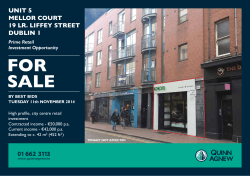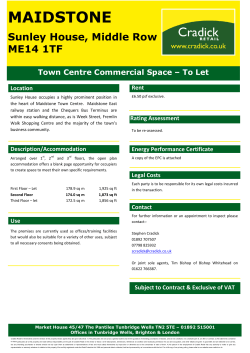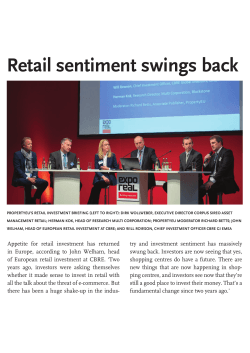
Off market sales of Dublin offices are proving to be
Buying property under the radar Donal Buckley Sunday Business Post Off market sales of Dublin offices are proving to be an effective way of sustaining the interest of active larger buyers at a time when some of these buyers are beginning to show signs of fatigue with the open market process. In contrast large retail investors are expected to be more willing to engage with the open market process. These are among the views of Sean O’Neill, director of TWM Select, the property investment advice specialists. His research has shown that off market office deals accounted for €620m worth of Dublin City centre office investment sales involving 11 deals over the 18 months to the end of May. That is 75pc of the €830m worth of office deals during the period. The off market deals included: A&L Goodbody offices for €58million; 1 Grand Canal for €93.5million; Riverside II for €50million; 75 Stephen’s Green for €74 million and EBS Building, Burlington road, €46.5million. Since TWM compiled these figures, one of the biggest off market deals has been seen with Green REIT’s acquisition of the Project Saphire properties for €375m. CoStar News reported that this deal saw Cosgrave Property Group invite a prospective buyers who also included Hibernia REIT, IPUT, Irish Life and Kennedy Wilson Europe to bid for the portfolio which comprised office buildings at Georges Quay and George’s Court, Dublin 2, in addition to retail and other commercial space in Westend Retail Park, Blanchardstown, Dublin 15. These deals are just some examples of how the off market process is the preferred approach of many Dublin office property owners although other vendors such as NAMA / receivers require an open market approach. O’Neill says the changing sales strategy is simply a reflection of the progression of the market cycle. “In the early part of the cycle where pricing is uncertain and vendors are not sure of the depth of the market, or indeed who the purchasers are, it is essential to market properties widely and publicly. This ensures that the property is exposed to as wide an audience as possible and all potential purchasers are aware of the opportunity. It provides comfort to the vendor that they have achieved the best price. “As the market matures and settles down, it becomes automatically more transparent. With more activity and sales, pricing becomes more predictable and the investor audience more consistent,” he says. In contrast the retail market is in a different phase of the market cycle. Project Acorn, a portfolio of shopping centres, is being sold on the market by NAMA. This is the first significant sale in the retail sector where there are significant asset management angles. As a result there is uncertainty around pricing and buyers. He expects new bidders to enter the market for these retail assets. “Many existing office investors won’t crossover to the provincial retail market at this stage. Therefore a public sale is the appropriate approach for Acorn,” O’Neill says. He also expects that a number of full open market retail sales will take place before transparency emerges and investors get comfortable with this sector. “It will be important for these new entrants, through their local advisors, to get under the skin of the market quickly and make the most of the early opportunities emerging,” he adds. A key appeal of the off-market deals for both buyer and vendor is the savings in cost and time because it allows a more targeted sales approach. This can be either a one to one negotiation or an offer to a small number of prospective buyers. One-to-ones occur in special circumstances such as occurred when Loanstar bought 28-31 Adelaide Road as it had already acquired the underlying debt. Other off market deals involve a small number of parties who have become not alone active bidders but have credible track records as buyers. Professionals intimately involved in the market will know who to target. Property investment advisors will regularly update their clients on market pricing and activity and who has the hot money in other words the keenest bidders with cash raised and ready to invest. This advice would include tracking successful bidders and more importantly the under bidders who still have capital to deploy. From the sale side, the off market approach maintains discretion and engagement from buyers. As with full open marketing, vendors now prepare all of the due diligence in advance and provide this, to potential purchasers, through a data room during the sale process. This due diligence comprising measured surveys, building surveys etc are made available to prospective purchasers. Thus potential issues are discovered before marketing and are then either remedied or flagged to prospective bidders. This focused approach also allows the vendor’s advisors to present to potential purchasers one-on-one and explain the intricacies and potential of the asset. Once the marketing process is complete and a preferred bidder identified, contracts can be exchanged quickly as the due diligence is complete thereby reducing the risk of a price re negotiation or an investor pulling out of the deal. “It also saves on marketing costs such as glossy brochures, advertising etc,” Mr O’Neill says. More importantly it addresses the recent emergence of bidding fatigue which has resulted from open market processes which involve large numbers of possible bidders and a number of bidding rounds. These have required potential buyers to spend significant amounts of time and money preparing bids only to find their chances of success can be very low. Evidence of this fatigue was reflected in some recent sales as some bidders were turned off by the two round process. “In a recent sale the second round became a tender process and this resulted in a number of potential bidders backing out,” he says. Marketing clarity is essential from day one and consequently investors are now focussing their efforts on those sales processes where they can have higher odds of success. Furthermore because they can focus on fewer deals they can save on resources which they can devote to identifying the potential for maximising potential returns. This in turn can enable buyers to be more aggressive in their pricing and consequently this can benefit the vendor in achieving premium pricing.
© Copyright 2025










